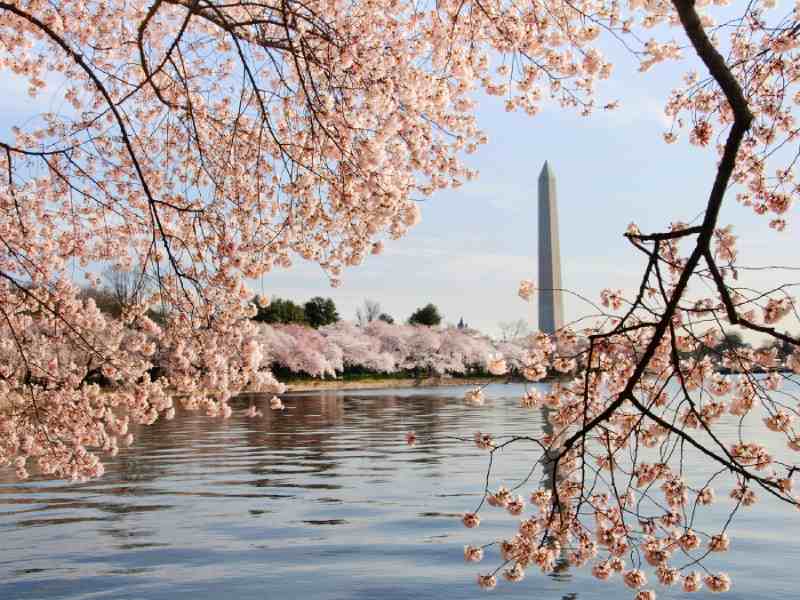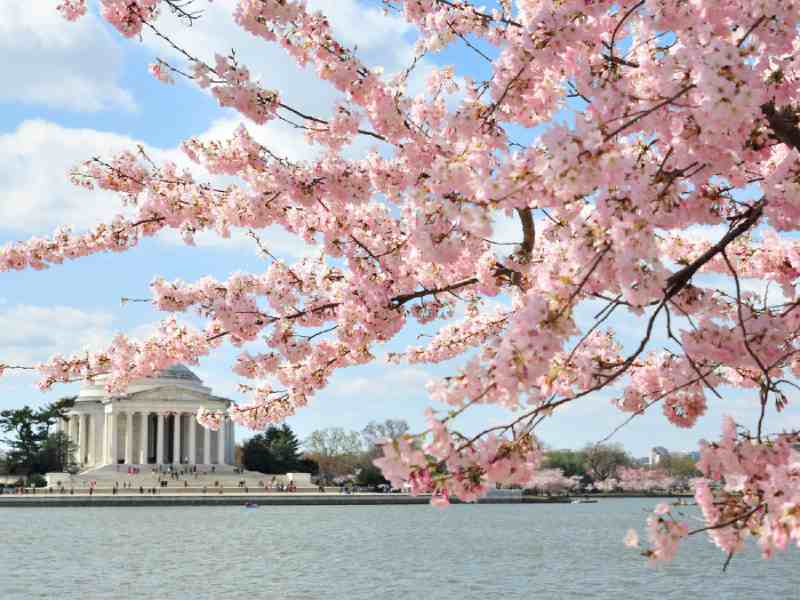
It’s that magical time of the year when Washington, DC bursts into mesmerizing shades of pink and white as the infamous cherry blossoms bloom! The annual blooming of cherry blossoms has been sought out by plant lovers for almost a century. So, what if you got to have some of that magic right in your front yard? That’s right, it’s possible, and we’ve got everything you need to know in order to grow your own cherry blossom in the DC area!
Why Do We Have so Many Cherry Blossom Trees in the DC Area
It’s no secret that cherry blossoms are not a native tree species in the United States, so why do we have so many in our capital? Well, in 1909 First Lady Helen Taft was contacted by a local diplomat and world traveler Eliza Scidmore who had optimistic plans to plant cherry blossoms in the city. Mrs. Taft was supportive of the idea, and eventually, the Mayor of Tokyo heard through the grapevine about these plans. As a sign of friendship, the Mayor gifted Mrs. Taft over 2,000 cherry blossoms!
Tragically, when those 2,000 cherry blossoms arrived in the USA, the Department of Agriculture determined that the trees were infested by pests and disease, and would damage local wildlife if planted. The difficult decision was made to destroy the entire shipment of trees. When word got back to the Mayor of Tokyo, he immediately agreed to send another shipment of trees, and this time he sent 3,000! The twelve varieties of cherry blossoms were planted throughout Washington, DC, over half of which were Yoshino cherries. Several decades later, the gift of giving continued, and another shipment of 3,000 trees was given to First Lady Lady Bird Johnson. Since then, the lineage of trees has continued through careful propagation efforts and donations from local nurseries!
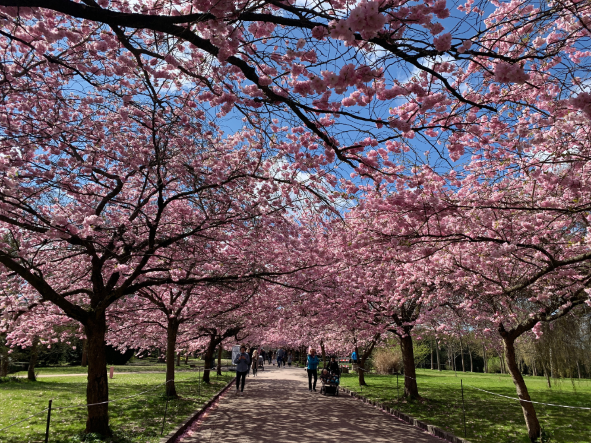
Cherry Blossom Lifespans and Health Considerations
Cherry blossoms are considered relatively short-lived trees. With the proper care, most cherry blossoms live between 30-40 years. They are a non-native species to the area, so they aren’t as well adapted to thrive in our environment. On the other hand, some native cherry trees, like the black cherry, can live up to 250 years!
If you think that’s impressive, wait till you learn about Jindai-zakura. Jindai-zakura is the name of the oldest living cherry blossom tree; it is believed that the tree is 2,000 years old! This magnificent feat of life is located in Japan, where it has been tenderly taken care of for centuries.
While it is unlikely that your personal cherry blossom will live that long, you can still get decades of beauty and fulfillment by taking care of your tree! Before deciding if you want to plant a non-native cherry blossom tree in your yard, it’s a good idea to look into all the requirements and maintenance needed to get the most from your tree. If you’re looking to snack on some cherries, then these aren’t the ones to plant! Cherry blossoms do bear small yields of fruit, but they are inedible to humans. These ornamental trees are beloved for their looks alone, so try a native non-ornamental cherry tree if you’re after the fruit!
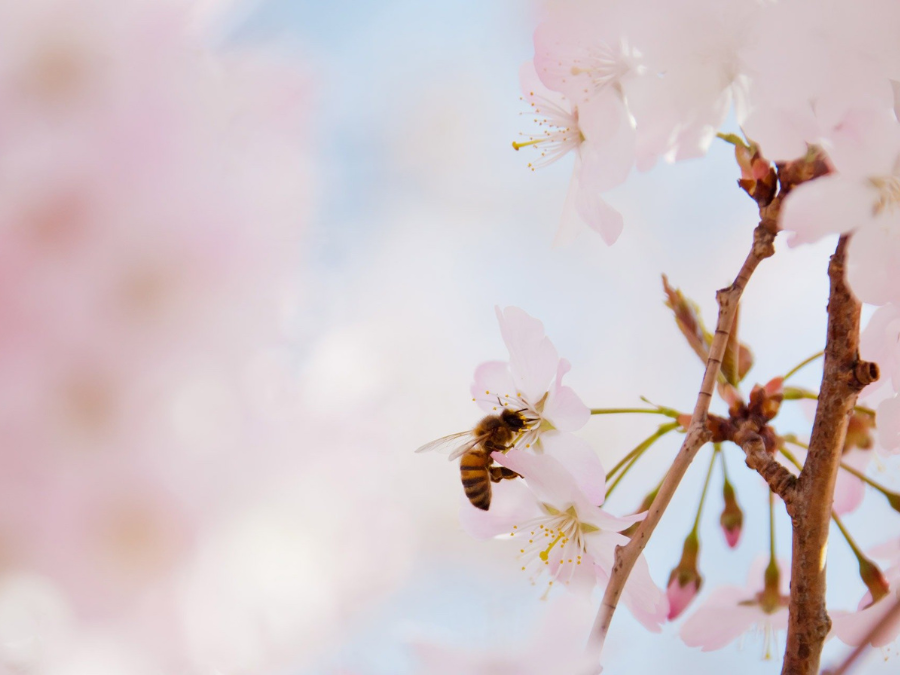
The Best Environment for Growing a Healthy Cherry Blossom Tree
Like any other tree, In order for cherry blossoms to flourish, they need to be planted in the right environment. These beauties do best in hardiness zones 5-8; luckily DC and Northern Virginia’s climate fall right in at hardiness zone 7! Cherry blossoms prefer full sun, but can also tolerate partial shade – they just may not yield as many flowers in shady areas. When it comes to soil, slightly acidic soil works best. Depending on the species, sandy or clay soil works fine, but generally loamy soil is a good choice for cherry blossoms. Perhaps the most important factor is having well-drained soil because these trees are susceptible to root rot. Last, but certainly not least, ensure they have room to grow! A cherry blossom will grow between 20-40ft high and the canopy will spread out to 30ft!
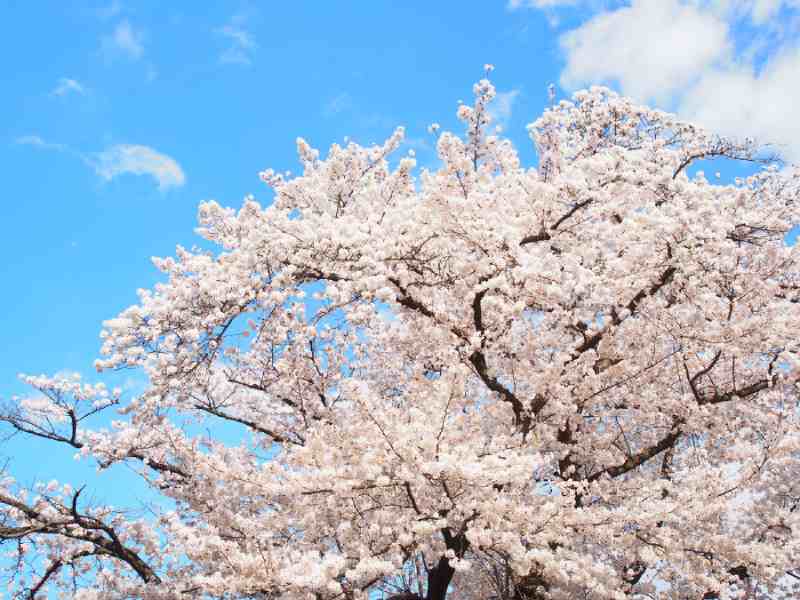
If You Want to Buy a Cherry Blossom Tree
That’s right, you can grow your own cherry blossom! If you love cherry blossoms and want to avoid the hassle of making it to Tidal Basin during peak season, you can bring the cherry blossom festival to your home by planting one! The two most prominent species found throughout Tidal Basin are the Yoshino cherry (Prunus x yedoensis) and the Kwanzan cherry (Prunus x serrulata ‘Kwanzan’). It’s not particularly common to find cherry blossoms at local nurseries for purchase, so you may need to travel or order one.
When to Plant or Transplant
Before planting a new tree on your property, it is a good idea to have an arborist take a look at your home to determine the best location for the tree! The best time to plant or transplant a cherry blossom is after the last frost in early spring. This gives the tree plenty of time to establish itself before the harshness of winter rolls through.
The Ideal Tree Age for Healthy Transplanting
Generally, the bigger a tree is the more complicated it is to transplant. Not only because of size, but because the root system has already been established elsewhere. Ideally, waiting until the tree sapling is about 2-3ft in height is the best time. This is not a firm rule, you can certainly transplant larger trees, they will just require more complex equipment and the knowledge of an arborist!
How to Care for a Newly-Transplanted Cherry Blossom Tree
A newly transplanted tree needs time to establish itself in a new environment. During this tender state, your cherry blossom will need a little extra TLC in order to thrive for years to come.
Watering Tips:
- Prunus are susceptible to root rot, so they need well-drained soils to ensure water does not settle around the roots for too long.
- Water young trees once a week for the first season, until they get established. A slow deep drench is better than a quick watering!
- Once your cherry blossom is well established, it can typically survive on just rainwater! If we have a long dry spell, giving them some water once a week is a good idea.
Mulching Tips:
- Avoid mulch volcanoes. Piling mulch up around the trunk of a tree is dangerous and leads to diseases. Make sure the mulch is flush with the root flare on the tree, not higher.
- Choose a mulch that will compensate for the nutrients your specific soil type lacks.
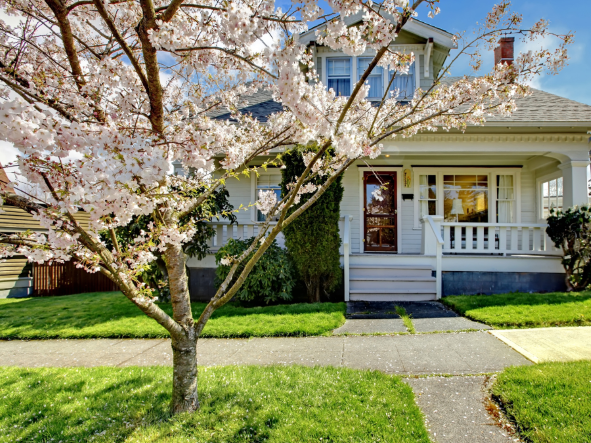
If You Already Have a Cherry Blossom Tree
If you’re lucky enough to already have a wonderful cherry blossom in your yard, then we have some extra information to help you keep it flourishing every year!
The Biggest Concerns for Older Cherry Blossom Trees
Regardless of species, when trees are near the end of their lifespan they become more susceptible to damage. This is because older trees grow and heal at a slower rate than younger trees. In order to increase the longevity of your cherry blossom, monitor it regularly to inspect for disease and damage – be careful when mowing near the base of the tree to avoid creating a wound on the trunk. Eventually, as the tree does die, it is crucial to call a professional tree company to remove it safely. Dead trees are considered very hazardous, and the longer they have been dead the more dangerous the removal becomes.
Common Pests and Diseases
Like any tree, cherry blossoms are not free from the wrath of pests and diseases. Keeping your tree healthy will go a long way in keeping problems at bay.
The most common pests that affect cherry blossoms are aphids, caterpillars, Japanese beetles, and borers. Check out each of the articles to get all the details on how to spot these critters and what you can do to stop them!
As for diseases, the most common diseases and fungal infections that affect cherry blossoms are cherry shot-hole fungus, powdery mildew, silver leaf fungus, and black knot fungus.
Here’s how you can identify each one:
- Cherry Shot-hole Fungus: the most obvious sign will be tiny holes in infected leaves, which give this disease its namesake. The holes begin as small red/brown spots which enlarge until the plant tissue falls out of the center, thus creating the holes. The leaves can also turn yellow and drop off in severe cases.
- Powdery Mildew: this infection begins as round white spots on leaves and stems. As the fungus spreads, it appears as gray dust encompassing most of the tree. Additionally, leaves tend to dry out and turn yellow or appear scorched.
- Silver Leaf Fungus: the first sign of this infection is a silver sheen across the surface of leaves. The leaves may also have dead brown spots.
- Black Knot Fungus: this fungus forms abnormal black growths on the twigs and branches of infected trees. This causes stem die-back and infected branches to fail to leaf out.
The Best Annual Treatments for Healthy Cherry Blossom Trees
Cherry blossom trees are relatively low-maintenance. They require little upkeep, so a little love goes a long way to keep them happy and healthy! Our team of experts recommends the following maintenance in order to have the healthiest cherry blossoms.
Bio-Stimulants: Just because cherry blossoms are low-maintenance trees doesn’t mean we recommend not giving them any help! Applying a multivitamin bio-stimulant twice a year will ensure your trees are getting the nutrients they need to stay healthy and increase resilience to pests and diseases.
Mulch: Properly applying mulch can greatly improve the resilience of trees. A layer of mulch around the tree (but not piled against it) will help the tree retain moisture and regulate its temperature throughout the seasons!
Prune: Ornamental trees usually do not need annual pruning. Our certified arborists say that pruning every 3-5 years to manage the size of the tree will suffice. Pruning too often can affect bloom production.
Learn more about caring for your cherry blossom trees with an RTEC expert!
